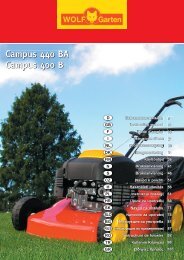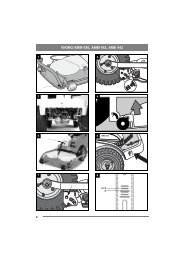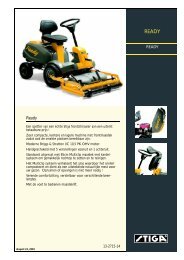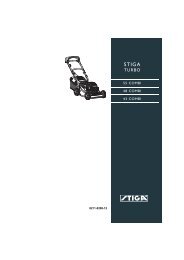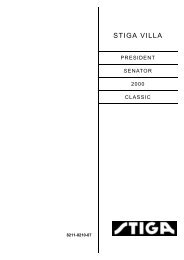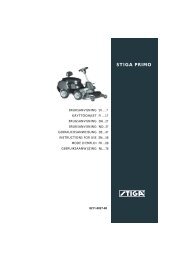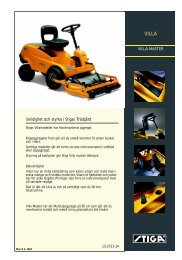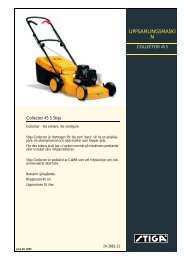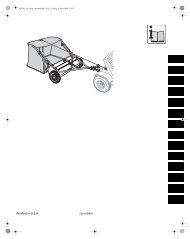STIGA PARK
STIGA PARK
STIGA PARK
You also want an ePaper? Increase the reach of your titles
YUMPU automatically turns print PDFs into web optimized ePapers that Google loves.
• Lifting. Press the rear part of the switch until<br />
the implement is in its highest position (transport<br />
position). Then release the switch and the<br />
height is locked in transport position.<br />
• Locking in transport position. The switch has<br />
reverted to neutral position after lifting. The implement<br />
is locked in transport position.<br />
NOTE! The hydraulic implement lifter must be<br />
in floating position in order for the power takeoff<br />
to be engaged.<br />
NOTE! The power take-off cannot be engaged<br />
when the parking brake is activated.<br />
2.4.3 Clutch-parking brake (3:B)<br />
Never press the pedal while driving.<br />
There is a risk of overheating in the<br />
power transmission.<br />
The pedal (3:B) has the following<br />
three positions:<br />
• Released. The clutch is not activated. The parking<br />
brake is not activated.<br />
• Depressed halfway. Forward drive disengaged.<br />
The parking brake is not activated.<br />
• Pressed down. Forward drive disengaged. The<br />
parking brake is fully activated but not locked.<br />
•<br />
2.4.4 Inhibitor, parking brake (3:A)<br />
The inhibitor locks the “clutch-brake”<br />
pedal in the depressed position. This function<br />
is used to lock the machine on slopes,<br />
during transport, etc., when the engine is<br />
not running.<br />
The parking brake must always be released<br />
during operation.<br />
Locking:<br />
1. Depress the pedal (3:B) fully.<br />
2. Move the inhibitor (3:A) to the right.<br />
3. Release the pedal (3:B).<br />
4. Release the inhibitor (3:A).<br />
Unlocking:<br />
Press and release the pedal (3:B).<br />
ENGLISH EN<br />
2.4.5 Driving-service brake (3:F)<br />
The pedal (3:F) determines the gearing ratio between<br />
the engine and the drive wheels (= the<br />
speed). When the pedal is released, the service<br />
brake is activated.<br />
1. Press the pedal forward –<br />
the machine moves forward.<br />
2. No load on the pedal – the machine<br />
is stationary.<br />
3. Press the pedal backward –<br />
the machine reverses.<br />
4. Reduce the pressure on the<br />
pedal – the machine brakes.<br />
2.4.6 Steering wheel (3:D)<br />
The height of the steering wheel is infinitely adjustable.<br />
Undo the adjustment knob (3:E) on the<br />
steering column and raise or lower the steering<br />
wheel to the desired position. Tighten.<br />
Do not adjust the steering wheel during<br />
operation.<br />
Never turn the steering wheel when the<br />
machine is stationary with a lowered<br />
implement. There is a risk of abnormal<br />
loads on the servo and steering mechanisms.<br />
2.4.7 Throttle control (4,5:G)<br />
Control for setting the engine’s revs.<br />
1. Full throttle – when the machine is in<br />
operation, full throttle should always be<br />
used.<br />
2. Idling.<br />
2.4.8 Choke control (4,5:H)<br />
A pull-type control to choke the engine when starting<br />
from cold.<br />
1. Control fully pulled out – choke valve<br />
in carburettor closed. For starting cold engine.<br />
2. Control pushed in – choke valve open.<br />
For starting warm engine and when operating<br />
the machine.<br />
Never operate the machine with the choke<br />
pulled out when the engine is warm.<br />
2.4.9 Ignition lock/headlight (4,5:I)<br />
The ignition lock is used for starting and stopping<br />
the engine. The ignition lock is also the switch for<br />
the headlight.<br />
65



